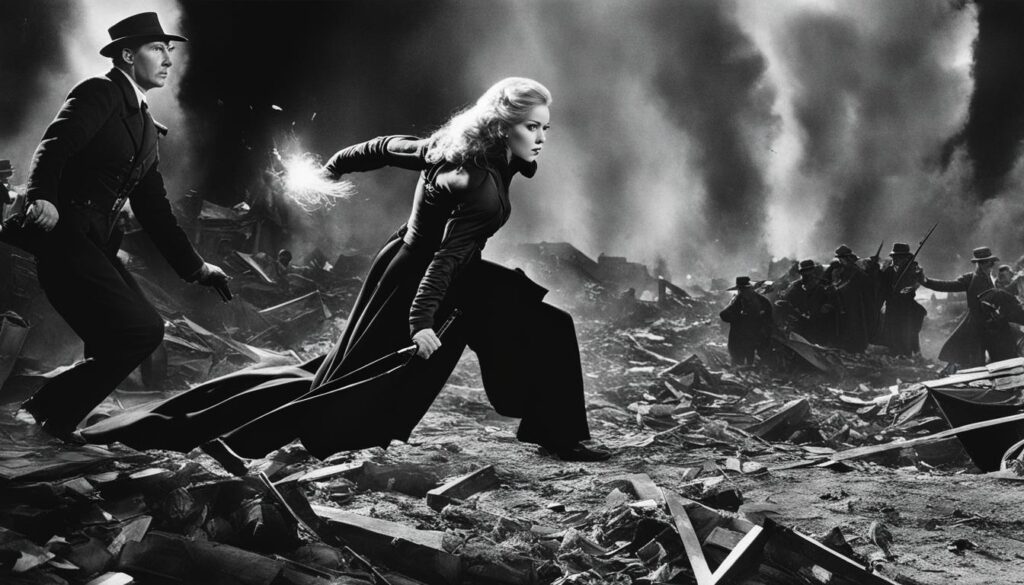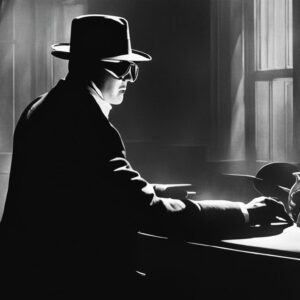Welcome to my movie review of The Invisible Woman (1940). In this classic film, you will embark on a journey filled with mystery, comedy, and romance. Join me as we delve into the unique twists and turns of this captivating piece of cinema history.
Key Takeaways:
- The Invisible Woman (1940) is a timeless classic that combines comedy, sci-fi, and romance.
- This film takes a genre shift by infusing horror with dark comedy, creating a fun and entertaining viewing experience.
- Follow the intriguing plot filled with an absent-minded inventor, an invisibility machine, mobsters, and unexpected side effects.
- Discover the talented cast, including Virginia Bruce, John Howard, and the legendary John Barrymore.
- Experience the subversive elements of screwball comedy and the battle of the sexes, providing a fresh take on traditional romance.
Genre Shift in The Invisible Woman (1940)
The Invisible Woman (1940) introduces a refreshing genre shift, straying from the horror movie formula of its predecessors. Instead, it embraces the elements of sci-fi comedy and dark comedy, creating a unique and entertaining viewing experience. This unexpected turn takes the concept of invisibility and transforms it into a live-action cartoon, blending horror elements with humor in a delightful way.
In this genre shift, The Invisible Woman (1940) offers a departure from the intense and suspenseful nature of the previous Invisible Man films. It embraces a lighter tone, focusing on comedic elements and absurd situations. The film embraces the idea of invisibility as a catalyst for humor, injecting a playful and whimsical energy into the narrative.
The Invisible Woman (1940) takes the horror movie concept of invisibility and transforms it into a sci-fi comedy that is full of laughs and entertainment. It effectively combines horror elements with dark comedy, subverting expectations and providing a fresh take on the genre.
This genre shift in The Invisible Woman (1940) not only showcases the versatility of the concept of invisibility but also highlights the creativity and innovation of the filmmakers involved. It adds a layer of amusement to the story while maintaining the core elements of an enjoyable classic film. The result is a movie that stands out for its sci-fi comedy and dark comedy elements, providing a unique viewing experience for audiences.
Table: Genre Shift in The Invisible Woman (1940)
| Genre | Elements |
|---|---|
| Sci-Fi Comedy | Combines science fiction elements with comedic moments |
| Dark Comedy | Blends humor with darker and twisted elements |
| Horror Movie | Deviation from the intense and suspenseful nature |
The Plot of The Invisible Woman (1940)
The Invisible Woman (1940) tells the intriguing story of Professor Gibbs, an absent-minded inventor who creates a groundbreaking invisibility machine. Eager to prove the success of his invention, he sets out to find a human test subject. Enter Kitty Carroll, a spirited and adventurous young woman who agrees to undergo the experimental transformation. However, as Kitty embraces her newfound ability to turn invisible, she soon discovers that being unseen comes with unexpected consequences.
As the plot unfolds, Kitty begins to experience strange side effects from the invisibility machine. These side effects create both comedic and dramatic moments throughout the film. Meanwhile, a group of mobsters becomes aware of the machine’s existence and sets their sights on stealing it for their own nefarious purposes.
The film takes viewers on a thrilling journey filled with suspense, romance, and unexpected twists. It explores the challenges and moral dilemmas that come with possessing such extraordinary powers. Will Kitty be able to navigate the dangers of invisibility and protect the machine from falling into the wrong hands? The plot keeps audiences on the edge of their seats, eager to find out what happens next.
The Main Characters:
- Professor Gibbs: An absent-minded inventor who creates the invisibility machine and leads the experiment.
- Kitty Carroll: A brave and adventurous woman who becomes the human test subject for the invisibility machine.
- Mobsters: A group of criminals who discover the existence of the machine and seek to steal it for their own gain.
The plot of The Invisible Woman (1940) captivates viewers with its unique blend of science fiction, romance, and suspense. Through the experiences of Kitty Carroll and the pursuit of the invisibility machine by mobsters, the film offers a thrilling and entertaining story that keeps audiences engaged until the very end.
The Development of The Invisible Woman (1940)
The development of The Invisible Woman (1940) began immediately after the release of The Invisible Man Returns. The screenplay for the film was written by Robert Lees and Frederic Rinaldo, who were known for their work in comedy films. With their experience in the genre, they were able to inject humor into the script, creating a unique blend of comedy and sci-fi elements for The Invisible Woman.
A. Edward Sutherland, a prolific filmmaker known for his work in comedy, was chosen to direct the film. His expertise in the genre allowed him to bring out the comedic elements and ensure that the film maintained a lighthearted tone. Sutherland’s direction, combined with the witty screenplay, set the stage for a comedic take on the traditional horror genre of the Invisible Man series.
| Development | Crew Members | Screenplay | Director |
|---|---|---|---|
| The Invisible Woman (1940) | Robert Lees and Frederic Rinaldo | Comedy and sci-fi elements | A. Edward Sutherland |
The collaboration between the screenplay writers and the director resulted in a film that pushed the boundaries of the Invisible Man series, introducing a new genre shift towards comedy. The development of The Invisible Woman showcased the creativity and talent of the crew members involved, as they successfully executed the vision of turning a horror movie into a comedic experience.
With a team of experienced comedy writers and a director well-versed in the genre, The Invisible Woman (1940) was able to break new ground and bring a fresh perspective to the Invisible Man series. The film’s development laid the foundation for a highly entertaining and comedic take on the classic tale of invisibility.
The Cast of The Invisible Woman (1940)
The Invisible Woman (1940) features a talented cast that brings the characters to life. Leading the film is Virginia Bruce, who portrays the confident and witty Kitty Carroll. John Howard delivers a charming performance as Dick Russell, a playboy who becomes intertwined in the chaos caused by the invisibility machine. Notably, the highly respected actor John Barrymore makes a memorable appearance, adding depth to the cast.
Virginia Bruce, playing the lead role of Kitty Carroll, brings both beauty and intelligence to the character. Through her portrayal, Bruce captures the essence of a woman who embraces newfound power and challenges societal expectations. Her natural charisma shines through, making her a captivating presence on screen.
John Howard’s portrayal of Dick Russell adds a layer of romance and intrigue to the film. As the chemistry between Kitty and Dick unfolds, Howard’s performance showcases the complexities of his character, from a charming playboy to a man who discovers a deeper connection.
John Barrymore’s cameo appearance in The Invisible Woman (1940) is a delightful addition to the cast. Known for his exceptional talent, Barrymore delivers a memorable performance, further elevating the film.
| Cast Member | Role |
|---|---|
| Virginia Bruce | Kitty Carroll |
| John Howard | Dick Russell |
| John Barrymore | Cameo Appearance |
The Screwball Comedy Elements in The Invisible Woman (1940)
The Invisible Woman (1940) falls into the subgenre of screwball comedy, a popular genre during the 1930s and early 1940s. This film subverts traditional romance tropes and features a strong, clever, and outspoken female protagonist, Kitty Carroll. The incorporation of screwball comedy elements adds a refreshing twist to the storyline, making it both entertaining and thought-provoking.
Throughout the film, Kitty challenges societal expectations and gender norms, embodying independence and empowerment. Her invisibility allows her to outsmart the men around her and take control of her own destiny. This battle of the sexes theme is a recurring motif in screwball comedies, and The Invisible Woman (1940) is no exception.
The comedic elements in the film are highlighted through farcical situations, witty banter, and slapstick humor. These elements add a lighthearted and humorous tone to the storyline, providing audiences with a delightful viewing experience. The film’s combination of screwball comedy and fantasy/sci-fi elements showcases the creative versatility of the genre.
| Key Elements of Screwball Comedy in The Invisible Woman (1940) |
|---|
| Strong, clever, and outspoken female protagonist |
| Battle of the sexes theme |
| Farcical situations and witty banter |
| Slapstick humor |
The Invisible Woman (1940) successfully incorporates screwball comedy elements to create a unique and entertaining film. Through the lens of humor and satire, the film explores gender dynamics and challenges societal norms, making it a standout addition to the Invisible Man series.
The Slapstick and Battle of the Sexes in The Invisible Woman (1940)
The Invisible Woman (1940) incorporates elements of slapstick comedy and explores the battle of the sexes, creating a humorous and thought-provoking dynamic. The film uses slapstick humor, characterized by exaggerated physical comedy and absurd situations, to entertain the audience. The invisibility power of Kitty Carroll, the female protagonist, adds an extra layer of comedic chaos to the story.
In the film, Kitty uses her invisibility to outsmart the men around her and challenge traditional gender roles. This highlights the power dynamic between men and women, as Kitty turns the tables and takes control in humorous and unpredictable ways. Through the lens of comedy, The Invisible Woman sheds light on the societal expectations and stereotypes that women face, offering a satirical commentary on gender dynamics.
“In comedy, we often find a safe space to explore and challenge societal norms. The slapstick elements and battle of the sexes in The Invisible Woman (1940) serve as a platform to address gender power dynamics, providing both entertainment and a critique of traditional gender roles.”
The Power Dynamic in Slapstick Comedy
Slapstick comedy has a long history of subverting power dynamics and societal norms, often using physical humor and exaggerated situations as a means of critique. In The Invisible Woman (1940), the power dynamic between men and women is a recurring theme. Kitty’s invisibility allows her to regain control and challenge the traditional male-dominated order.
This power shift creates comedic tension as Kitty uses her newfound powers to navigate through chaotic situations, ultimately shaping her own destiny. The film’s slapstick elements serve to highlight the absurdity of the power imbalances between genders and provide a platform for social commentary.
Overall, The Invisible Woman (1940) combines slapstick comedy and the battle of the sexes to create an entertaining and thought-provoking film. By exploring the power dynamics between men and women through humor, the film offers a playful yet insightful commentary on gender roles and expectations.
| Elements | Description |
|---|---|
| Slapstick Comedy | The film incorporates physical humor and absurd situations to create comedic chaos. |
| Battle of the Sexes | The power dynamic between men and women is explored, with Kitty challenging traditional gender roles. |
| Power Dynamic | The film highlights the imbalances of power between genders and satirically critiques societal norms. |
The Outdated Romance Subplot in The Invisible Woman (1940)
The film features a romance subplot between Kitty Carroll and Dick Russell, a shallow playboy. Although this aspect adds a touch of traditional romance to the storyline, it has been criticized for perpetuating outdated gender dynamics. The portrayal of Dick as a shallow, charming womanizer perpetuates the idea of a traditional male/female power dynamic, focusing on physical appearance rather than substance.
Despite the criticism, it is important to note that The Invisible Woman (1940) was created during a time when societal norms and gender roles were different. The film reflects the values and expectations of that era, which may not align with contemporary views on gender equality. However, it is essential to view it within its historical context.
The romance subplot in The Invisible Woman (1940) highlights the need for critical analysis of media and the evolution of gender representation in film. While it may fall short in terms of modern sensibilities, it does provide an opportunity to reflect on the progress made in challenging traditional gender roles and expectations in the film industry.
The Outdated Romance Subplot in The Invisible Woman (1940)
| Aspect | Criticism | Historical Context | Opportunity for Reflection |
|---|---|---|---|
| Romance Subplot | Perpetuates traditional male/female power dynamics | Reflects societal norms and values of the time | Encourages critical analysis and discussion on gender representation in film |
| Dick Russell’s Character | Portrayed as a shallow playboy focused on physical appearance | Reflects historical attitudes towards dating and romance | Highlights the need for progress in challenging gender stereotypes and expectations |
The Shift from Horror to Comedy in The Invisible Woman (1940)
The Invisible Woman (1940) marks a significant shift from the horror genre of the previous Invisible Man films. While the films share a common element of invisibility, The Invisible Woman focuses on comedy and fantasy/sci-fi elements rather than horror. This genre shift provides a refreshing and entertaining twist to the franchise, attracting a wider audience with its humor and light-heartedness.
The narrative connection between The Invisible Woman and the earlier horror films lies primarily in the concept of invisibility. However, the tone and overall thematic focus differ greatly. The horror films explored the darker side of invisibility, with the protagonist succumbing to madness and committing heinous acts. In contrast, The Invisible Woman takes a more whimsical approach, transforming the concept into a source of comedic situations and imaginative storytelling.
By infusing comedy into the narrative, The Invisible Woman offers a unique take on the classic Universal Monsters universe. It embraces slapstick humor, clever wordplay, and absurd situations, ensuring laughter and entertainment throughout the film. While some fans of the horror genre may find this shift surprising, it showcases the versatility of the source material and the creative risks taken by the filmmakers.
The Genre Shift at a Glance:
| Horror Genre (Previous Invisible Man Films) | Comedy Genre (The Invisible Woman) |
|---|---|
| Dark and atmospheric tone | Light-hearted and comedic tone |
| Exploration of the dangers and consequences of invisibility | Showcasing the comedic and fantastical possibilities of invisibility |
| Themes of madness, power, and isolation | Themes of humor, romance, and empowerment |
The shift from horror to comedy in The Invisible Woman presents a fresh perspective on the Invisible Man series, proving that even the darkest of stories can be reimagined with a humorous twist. This genre shift not only adds to the diversity of the franchise but also highlights the endless creative possibilities when exploring iconic monsters in new and unexpected ways.
The Feminist Agenda in The Invisible Woman (1940)
The Invisible Woman (1940) promotes a feminist agenda by highlighting women’s rights and empowerment. The character of Kitty Carroll embodies a strong and independent woman who challenges societal norms. Through her decision to become invisible, she seeks to bring about change and challenge the mistreatment of women in her workplace and beyond.
“When I put on that invisibility thingamajig, I’m powerful. People have to listen to me. They have to respect me. I don’t have to be invisible to be invisible. Get it?” – Kitty Carroll
Kitty’s journey in the film showcases her determination to break free from traditional gender roles and demand the respect she deserves. By outsmarting and challenging the men around her, she effectively challenges the power dynamics between men and women, offering a message of invisible empowerment to women of the time and inspiring them to stand up for themselves.
The Invisible Woman (1940) serves as a reminder of the importance of women’s rights and the ongoing struggle for equality. While some elements of the film may be outdated, its underlying feminist themes remain relevant, making it a noteworthy addition to the Invisible Man series.
| Film Title | Feminist Themes |
|---|---|
| The Invisible Woman (1940) | Empowerment and Women’s Rights |
| The Invisible Man (1933) | Male Dominance and Control |
| The Invisible Man Returns (1940) | Heroism and Redemption |
The Comic Elements in The Invisible Woman (1940)
The Invisible Woman (1940) incorporates various comic elements throughout the film, providing comic relief, humorous situations, and absurdity to entertain the audience. These elements contribute to the overall comedic tone of the movie and add an extra layer of enjoyment to the viewing experience.
One of the main sources of comedy in the film is the use of slapstick humor. Slapstick comedy involves exaggerated physical actions and mishaps, often resulting in humorous and chaotic situations. The Invisible Woman (1940) utilizes slapstick to create hilarious moments, such as characters tripping, falling, or getting caught in absurd situations due to the invisibility effects.
Moreover, the film incorporates farcical situations that add to its comedic value. Farcical comedy relies on improbable and exaggerated events, creating absurd and amusing scenarios. The Invisible Woman (1940) takes advantage of the invisibility concept to introduce outlandish situations that generate laughter and amusement, further enhancing the overall comedic atmosphere.
The Invisible Woman (1940) is a prime example of a film that successfully infuses comic relief, humorous situations, and absurdity to create an entertaining and light-hearted viewing experience.
The Role of Comic Relief Characters
In addition to slapstick and farcical elements, the film features comic relief characters who contribute to the humorous tone of the story. These characters are often quirky, eccentric, or comically inept, providing comedic moments and lightening the mood during intense or dramatic scenes. Their presence alleviates tension and adds an extra layer of amusement to the narrative.
The comic relief characters in The Invisible Woman (1940) serve as a contrast to the more serious or sinister aspects of the plot, offering moments of laughter and levity. They provide comedic interactions and dialogue, ensuring that the film maintains its comedic essence throughout the story.
| Comic Relief Characters in The Invisible Woman (1940) | Description |
|---|---|
| George | A bumbling and accident-prone butler, who creates comedic situations through his clumsy actions and misunderstandings. |
| Marie | A sassy and sarcastic maid, who delivers witty remarks and humorous commentary on the unfolding events. |
| Professor Gibbs | An absent-minded inventor who unintentionally provides comic relief through his forgetfulness and humorous reactions to the chaos caused by the invisibility machine. |
These comic relief characters add depth and dimension to the comedic elements of The Invisible Woman (1940), ensuring that the film entertains and delights the audience from start to finish.
The Climactic Action in The Invisible Woman (1940)
As the narrative of The Invisible Woman (1940) reaches its climax, the action intensifies with the arrival of a group of ruthless gangsters determined to steal Professor Gibbs’ groundbreaking invisibility machine. This action-packed sequence injects a thrilling element into the film, adding suspense and excitement for the audience.
With her newly acquired ability to turn invisible, the film’s protagonist, Kitty Carroll, emerges as the unexpected hero. Armed with her extraordinary powers, she takes on the gangsters single-handedly, showcasing her resourcefulness and determination to protect the invisibility machine.
This action-packed climax not only showcases the adventurous side of the film but also highlights Kitty’s transformation from an ordinary woman to a powerful force to be reckoned with. It serves as a testament to her personal growth and empowerment throughout the story.
Overall, the climactic action of The Invisible Woman (1940) delivers an exhilarating conclusion, combining the elements of suspense, danger, and supernatural powers. It further enhances the film’s genre shift, presenting an engaging and action-packed finale for audiences to enjoy.
Gangsters Attempting to Steal the Invisibility Machine
| Gangsters’ Actions | Kitty’s Counteractions |
|---|---|
| The gangsters devise a plan to break into Professor Gibbs’ lab and steal the invisibility machine. | Kitty uses her invisibility powers to outsmart the gangsters, using misdirection and stealth to foil their plans. |
| They encounter Kitty in her invisible state, prompting a thrilling cat-and-mouse chase through the lab. | Kitty utilizes her agility and knowledge of the lab to evade the gangsters, leading them on a wild goose chase. |
| The gangsters corner Kitty, attempting to overpower her and retrieve the invisibility machine. | Kitty fights back with her invisible strength, delivering surprise attacks to thwart their advances. |
Conclusion
The climactic action in The Invisible Woman (1940) delivers a thrilling and action-packed finale that showcases the film’s genre shift and highlights the empowerment of the female protagonist. The battle between Kitty and the gangsters emphasizes her transformation from an ordinary woman to a formidable force, using her invisibility powers to protect the groundbreaking invention. This exciting sequence adds suspense, danger, and excitement to the film, leaving audiences satisfied with the thrilling conclusion.
The Conclusion of The Invisible Woman (1940)
As The Invisible Woman (1940) comes to a close, we find a satisfying romantic resolution that adds to the film’s comedic elements. Despite the questionable dynamics of their relationship, Kitty Carroll and Dick Russell find love and happiness. The film ends on a light-hearted note, reinforcing its overall comedic tone.
Throughout the movie, Kitty’s invisible empowerment is showcased, as she uses her newfound abilities to challenge traditional gender roles and demand respect. The feminist agenda of the film is evident in her actions, inspiring other women to stand up for themselves. While the romance subplot may have its shortcomings, it serves as a backdrop to the larger themes of female empowerment and societal change.
The Invisible Woman (1940) successfully combines comedy, sci-fi, and romance to offer a refreshing take on the genre. The film’s shift from horror to comedy adds a unique twist to the Invisible Man series, bringing a sense of fun and entertainment. It may have outdated elements, but it remains an enjoyable classic film that is worth watching for its comedic moments and underlying feminist undertones.
| Key Points | Details |
|---|---|
| Conclusion | The film concludes with a romantic resolution between Kitty Carroll and Dick Russell, despite the problematic elements of their relationship. |
| Comedic Elements | The Invisible Woman (1940) maintains an overall comedic tone with elements of slapstick, farcical situations, and absurdity. |
| Feminist Agenda | The film promotes a feminist agenda by highlighting women’s rights and empowerment through Kitty’s actions and challenges to societal norms. |
| Genre Shift | The Invisible Woman (1940) marks a significant shift from the horror genre of the previous Invisible Man films, adding a fresh perspective to the series. |
Conclusion
In conclusion, The Invisible Woman (1940) is a delightful film that offers a unique blend of comedy, sci-fi, and romance. It takes a genre shift from the horror elements of its predecessors and transforms into a live-action cartoon with dark comedic undertones. Despite some outdated romance subplots, the film’s comedic moments and feminist agenda make it an enjoyable classic worth watching.
With its screwball comedy elements, The Invisible Woman challenges traditional gender roles and explores the battle of the sexes. The slapstick comedy and absurd situations bring laughter to the audience, while the action-packed climax adds excitement and suspense. The film’s talented cast, led by Virginia Bruce and John Howard, delivers engaging performances that further enhance the viewing experience.
While The Invisible Woman (1940) may not have a direct narrative connection to the earlier films in the series, it stands on its own as an entertaining and lighthearted addition. Its feminist undertones, humorous moments, and refreshing take on the genre make it a film that should not be missed.
FAQ
What genre is The Invisible Woman (1940)?
The Invisible Woman (1940) combines elements of comedy, sci-fi, and romance.
How does The Invisible Woman (1940) differ from the previous Invisible Man films?
The Invisible Woman (1940) takes a genre shift by turning the horror movie into a live-action cartoon with comedy and fantasy/sci-fi elements.
What is the plot of The Invisible Woman (1940)?
The film follows the story of Professor Gibbs, an inventor who creates an invisibility machine and uses Kitty Carroll as a test subject. Complications arise when Kitty experiences side effects and a group of mobsters tries to steal the machine.
Who was involved in the development of The Invisible Woman (1940)?
The screenplay was written by Robert Lees and Frederic Rinaldo, and A. Edward Sutherland directed the film.
Who are the main cast members of The Invisible Woman (1940)?
The film features Virginia Bruce as Kitty Carroll, John Howard as Dick Russell, and John Barrymore in a supporting role.
What is the genre of The Invisible Woman (1940) in terms of comedy?
The film falls into the subgenre of screwball comedy, featuring a strong and clever female protagonist and exploring the battle of the sexes.
How does The Invisible Woman (1940) incorporate comedy?
The film uses slapstick comedy, absurdity, and farcical situations to create a comedic tone and highlight the power dynamic between men and women.
Is there a romance subplot in The Invisible Woman (1940)?
Yes, the film includes a romance subplot between Kitty and Dick Russell, but it has been criticized for its outdated portrayal of gender dynamics.
Does The Invisible Woman (1940) have a connection to the previous Invisible Man films?
While The Invisible Woman (1940) shares the common element of invisibility, it lacks a direct narrative connection to the earlier films in the series.
Does The Invisible Woman (1940) promote any social agenda?
Yes, the film promotes a feminist agenda by highlighting women’s rights and empowerment through Kitty’s actions and challenges to traditional gender roles.
How does The Invisible Woman (1940) incorporate comic elements?
The film includes comic relief characters, humorous situations, and elements of absurdity to create a comedic tone and provide entertainment for the audience.
What is the climactic action in The Invisible Woman (1940)?
The climax involves a group of gangsters attempting to steal the invisibility machine, and Kitty, with her newfound powers, becomes the hero and battles them to protect the machine.
How does The Invisible Woman (1940) conclude?
The film concludes with a romantic resolution between Kitty and Dick Russell, leaving the ending on a light-hearted note that reinforces its comedic tone.







